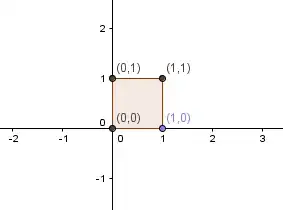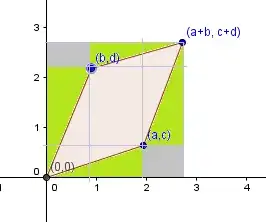Given the $2\times2$ matrix,
$$A=\begin{pmatrix} a & b \\ c & d \\ \end{pmatrix}$$
$\det(A)=ad-bc$
and the matrix, $$B=\begin{pmatrix}
0 & 1 & 0 & 1 \\
0 & 0 & 1 & 1 \\
\end{pmatrix}$$
which can represent a square with the vertices $(0,0),(1,0),(0,1)$ and $(1,1)$
the matrix given by multiplying them,
$$AB=\begin{pmatrix} 0 & a & b & a+b \\ 0 & c & d & c+d \\ \end{pmatrix}$$
can represent a parallelogram with vertices, $(0,0),(a,c),(b,d)$ and $(a+b,c+d)$
What I would like to do is to show that the area of this parallelogram is given by $$\det(A)=ad-bc$$.
It really boils down creating a general formula for the area of the parallelogram, and showing that it reduces to $ad-bc$.
I've started by calculating the area of the rectangle bounded by $(0,0)$ and $(a+b, c+d)$, which is $(a+b)(c+d)= ac+bc+ad+bd$.
Next, I've subtracted the areas of the figures that I've filled in with colours. Like colours don't imply like areas. Starting with the green triangle bounded by $(0,0)$ and $(a,c)$, and working counter clockwise, these are:
$ac;\; \frac{1}{2}bd;\; \frac{1}{2}ac;\; b(c+d)=bc+bd;\; \frac{1}{2}bd$
Subtracting these values from the original area:
$$ac+bc+ad+bd -\frac{3}{2}ac -2bd -2bc = ad-bc $$(minus a bunch of other stuff that shouldn't be there).
I suspect that my method is correct, but that I've either misrepresented the smaller areas or I've fumbled when sorting them out.
Can anyone please help me clean this up?
Thanks!


